#prunus armeniaca
Explore tagged Tumblr posts
Text

お花好きな住宅の花壇にある
鉢植えで咲いていた、
「アンズ(杏)」の花。
サクラ属。
別名:カラモモ、
アプリコット。
学名:Prunus Armenians
撮影:iPhone14 Pro Max
37 notes
·
View notes
Text
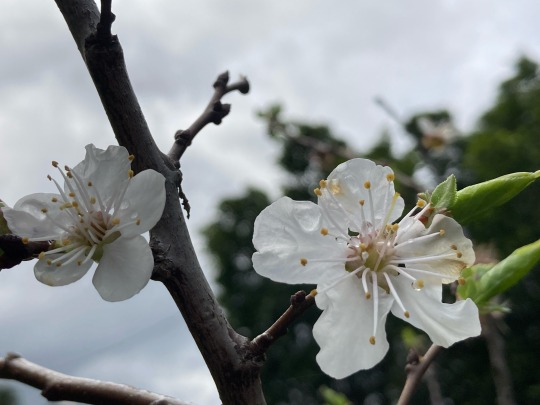


#apricot blossoms#apricot tree#prunus armeniaca#flowering trees#fruit trees#raindrops#water droplets#van nuys
25 notes
·
View notes
Text

Albaricoques
Imagen: rawpixel
0 notes
Text
Shuro's Retainers and the flowers from their nicknames
I really wanted to see what these flowers look like so I compiled some information about them. I tried to find the best info I could but it might not be 100% accurate (Things like flower language can vary and I couldn't find much in English)
Maizuru
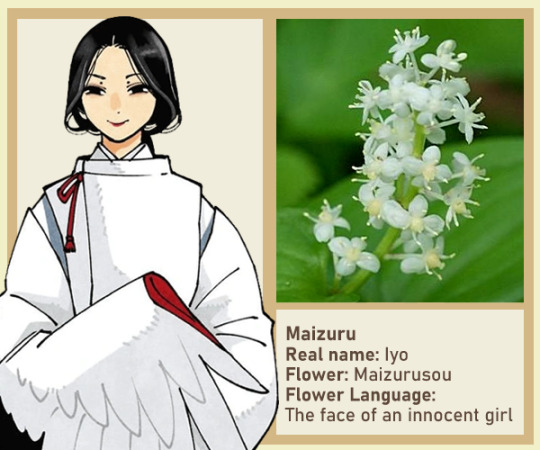
Real Name: Iyo Flower: Maizurusou (マイヅルソウ) English name: Snakeberry, False Lily Of The Valley Scientific name: Maianthemum dilatatum Flower Language (Hanakotoba): The face of a innocent girl
Hien
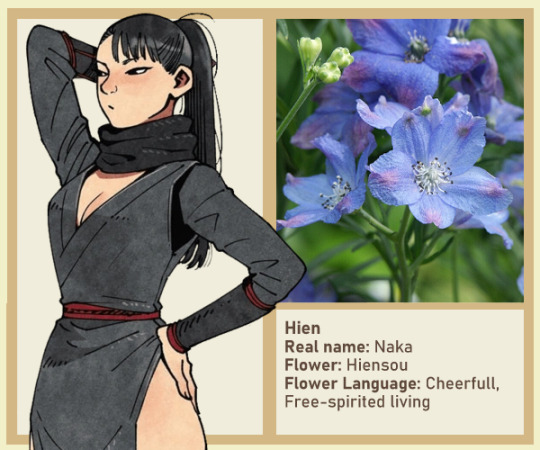
Real Name: Naka Flower: Hiensou (ヒエンソウ) English name: Doubtful Knight's Spur Scientific name: Consolida ajacis Flower Language (Hanakotoba): Lightness, cheerfulness, free-spirited living
Benichidori
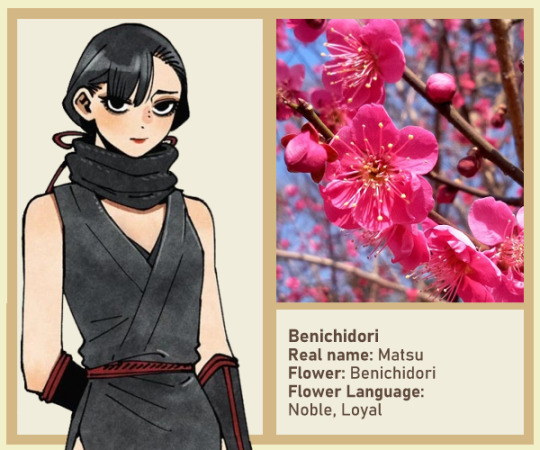
Real Name: Matsu Flower: Benichidori (紅千鳥) English name: Japanese plum Scientific name: Prunus mume, Armeniaca mume Flower Language (Hanakotoba): Nobility, Loyalty, Elegance
Inutade
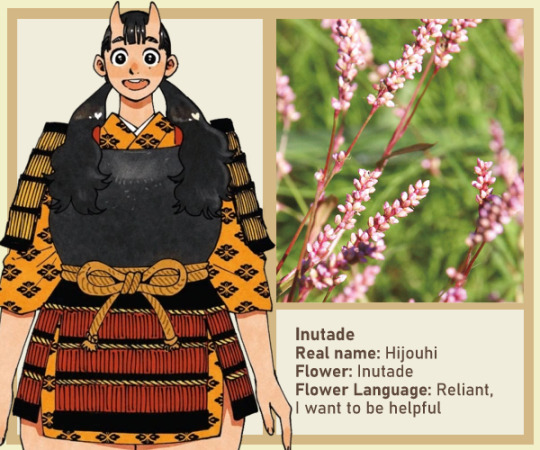
Real Name: Hijouhi Flower: Inutade (イヌタデ) English name: Bristled Knotweed Scientific name: Persicaria longiseta Flower Language (Hanakotoba): Reliant, Depedant, "I want to be helpful"
Asebi
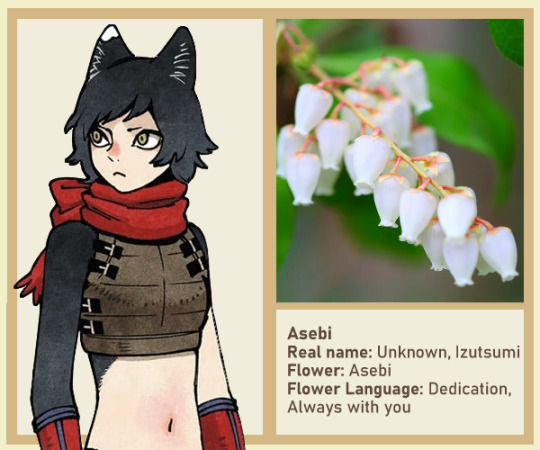
Real Name: Unknown, Izutsumi Flower: Asebi (アセビ) English name: Japanese Andromeda, Japanese Pieris Scientific name: Pieris japonica Flower Language (Hanakotoba): Dedication, Always with you, "I want to go traveling with you"
#dungeon meshi#Hope yall like the pretty flowers#Izutsumi#Inutade#Asebi#Benichidori#Hien#Maizuru#for referencing#Shuros party#Flower Language#hanakotoba#Graphic design is my passion#forgive me if I got something too wrong#edit: FIXED MAJOR TYPOS ON MAIZURUS im so sorry
2K notes
·
View notes
Text



Plant of the Day
Sunday 26 November 2023
This wall trained Prunus armeniaca ‘Tomcot’ (apricot) is a self fertile cultivar, like all apricots it flowers very early so they are best hand pollinated with a soft brush to aid fruit production. Protection from frosts when in blossom is essential but later in the year it is all about the autumn colour.
Jill Raggett
#prunus#apricot#fruit trees#fruit#autumn colours#walled garden#wall trained#fan trained#plants#horticulture#gardens#garden#Gordon Castle#scotland
114 notes
·
View notes
Text

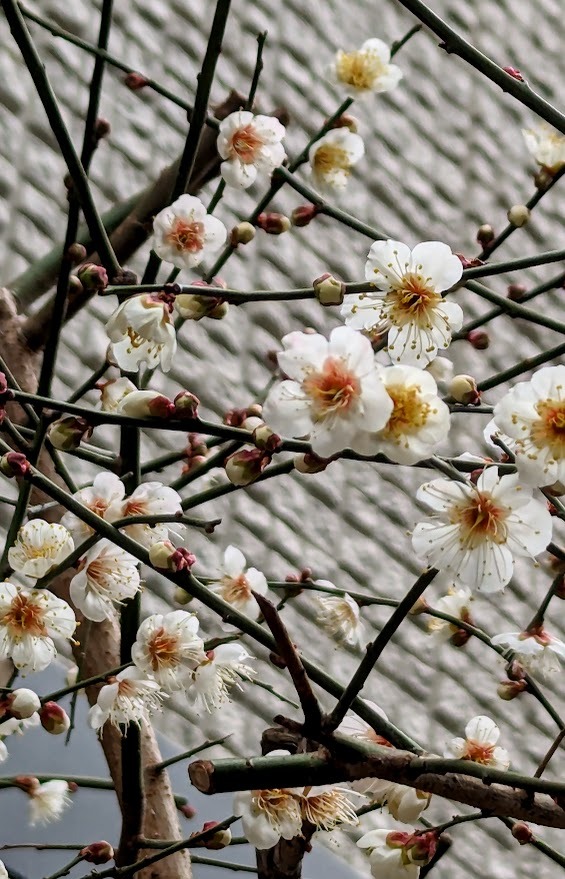

🎶ご近所 春の気配 三部作 ① ミツマタの蕾 - 三椏 / Edgeworthia chrysantha / Paperbush ② アンズの花 - 杏 / Prunus armeniaca / Apricot ③ 開花しだした沈丁花 - Daphne odora Thunb
51 notes
·
View notes
Text
https://github.com/amolbudhavant923/Edge-Round-Innovations-/blob/main/Prunus-Armeniaca-Fruit-Extract-Market.md
0 notes
Text
THUỐC ÔN PHẾ CHỈ KHÁI - HẠNH NHÂN (Semen Armeniacae amarae)
Là nhân của hạt quả mơ - Prunus armeniaca L. Họ Hoa hồng - Rosacene.
Tính vị: vị đắng, tính ấm. Quy kinh: vào kính phế. Công năng chủ trị:
Ôn phế chỉ khái, dùng với bệnh ho hàn, đàm trắng loãng.
Làm thông phế, bình suyễn, dùng đối với bệnh viêm khí quản, ho, khí quản suyễn tức; dùng bài Hạnh tô tán: hạnh nhân 8g, tô diệp, cát cánh, chỉ xác, trần bì, táo 3 quả, sắc uống.
Nhuận tràng thông tiện: dùng cho các chứng đường tiên hoá khô ráo, đại tiện bí kết, do tân dịch không đủ. Liều dùng: 4 - 12g. Kiêng kỵ: những người ỉa chảy không nên dùng, do có chất độc (HCN) cho nên lượng dùng không nên quá nhiều, không dùng cho trẻ con.
NguyênLiệuLàmThuốc #ThuốcÔnPhếChỉKhái
0 notes
Text
"You're like flowers in the depths of winter."
I read the first part of "A Bad Night" and I'm laughing hard.

Raffles planning to steal a wedding is mean as fuck, but the fact that is a very rich wedding with rooms full of presents and a security company to protect them sounds like a perfect opportunity for Raffles.
Bunny having a solo adventure is always nice, but Murphy's law attacks again and Bunny has to deal with a victim who's a Raffles fan, and is having an asthma crisis. Because our dear little bunny has a bit of moral sense he helped Medlicott.
"There's something in that," said he, "(...) And I congratulate myself," he was quick enough to add, "on having you to see me through as bad a night as I've had for a long time. You're like flowers in the depths of winter. Got a drink? That's right! I suppose you didn't happen to bring down an evening paper?"
Young Medlicott comparing Bunny with flowers is something so poetic. The first flower I thought was apricot blossom (Prunus armeniaca), that blossoms on late winter or early spring.

Dude (Medlicott), I love this comparison but you don't know that this is the guy who came to steal your wedding... Or at least he tries to steal it until another burglar appears. Raffles himself!
This is really a bad night for Bunny, but it's a funny night for me.
#letters from bunny#crime and cricket#aj raffles#bunny manders#a j raffles#be gay do crime#a bad night#BADN#letters in the underground
1 note
·
View note
Text
ALMOND BEAD VÀ NHỮNG ĐIỀU BẠN CẦN BIẾT
Almond Bead là những hạt nhỏ được tách ra từ vỏ bên ngoài của hạt hạnh nhân. Với những công dụng nổi bật cho làn da như:
- Chất tẩy tế bào chết không gây kích ứng da.
- Giúp làm đều màu da và giảm tình trạng thâm nám.
- Kích thước hạt tương tự nhau, hiệu quả giữa các hạt đồng điều.
- Bột vỏ Prunus Armeniaca còn giúp loại bỏ da chết bong tróc và mụn trên da.
ỨNG DỤNG:
- Sử dụng trong sản phẩm tẩy tế bào chết để loại bỏ tế bào chết, giúp da sáng mịn.
- Kết hợp với các thành phần khác để tạo mặt nạ dưỡng ẩm và làm sáng da.
0 notes
Text
Apricot Oil Drops Specifically Formulated To Support Hair Scalp & Skin!
Product Name: Apricot Oil
Brend Name: Kazima Cosmetics
Company Website: https://www.kazima.in/
Price: Check Website [Click Here]
Benefits: HairCare, SkinCare Etc
Order Website: https://www.kazima.in/apricot-oil/
Apricot Oil :- Apricot oil is a first rate natural product, particularly if you're simply starting to discover the arena of herbal oils for skincare and haircare. It's often known as a "miracle oil" because of its wide variety of advantages and gentle nature. Here’s the entirety you need to understand about apricot oil:

What is Apricot Oil?
Apricot oil is extracted from the kernels (seeds) of apricots, a fruit from the Prunus armeniaca tree. This oil is thought for its mild texture, mild fragrance, and a wealthy profile of critical fatty acids, nutrients, and antioxidants.
Types of Apricot Oil:
Cold-Pressed Apricot Oil: Extracted without the use of warmth, this approach preserves the oil's vitamins, making it the maximum useful for skin and hair.
Refined Apricot Oil: Processed with heat or chemical compounds, this model may additionally lose some of its nutrients however nevertheless retains its moisturizing properties.
Why is it Called a "Miracle Oil"?
Apricot oil is referred to as a "miracle oil" because it offers a couple of blessings for the pores and skin, hair, and ordinary health, all packed into one mild, smooth-to-use product.
Benefits of Apricot Oil:
Deep Moisturization:
For Skin: Rich in oleic acid (omega-nine) and linoleic acid (omega-6), apricot oil deeply hydrates the pores and skin, making it gentle and supple without leaving a greasy residue.
For Hair: It nourishes the scalp and hair, lowering dryness and selling healthier, shinier hair.
Anti-Aging Properties:
Vitamin A and E: These vitamins assist combat free radicals, lessen the appearance of exceptional lines and wrinkles, and enhance pores and skin elasticity.
Collagen Boost: Regular use can aid collagen production, preserving the skin firm and younger.
Soothing for Sensitive Skin:
Anti-Inflammatory: Apricot oil has soothing homes that calm indignant or sensitive pores and skin, making it perfect for conditions like eczema, rosacea, and psoriasis.
Gentle Nature: Its hypoallergenic qualities make it suitable for all skin kinds, together with touchy and acne-inclined skin.
Improves Skin Tone and Texture:
Brightening Effect: Apricot oil helps even out pores and skin tone, reduces darkish spots, and imparts a healthful glow to the pores and skin.
Smoothness: It smooths rough or flaky skin, leaving it smooth or even-textured.
Versatile and Multipurpose:
Facial Oil: Can be used as a each day moisturizer, serum, or introduced on your existing skincare products.
Body Oil: Perfect for after-bathe hydration or as a rubdown oil.
Hair Treatment: Works as a scalp treatment, depart-in conditioner, or frizz-taming serum.
How to Use Apricot Oil:
For the Face:
Moisturizer: Apply a few drops to easy pores and skin after cleaning and firming. Gently rubdown it into the skin until absolutely absorbed.
Serum: Use it as a serum through applying a small amount earlier than your everyday moisturizer to enhance hydration and pores and skin health.
For the Body:
Body Oil: Apply after a bath while your pores and skin remains damp to lock in moisture. It’s particularly effective on dry areas like elbows, knees, and heels.
Massage Oil: Apricot oil’s light texture makes it perfect for massages, leaving the pores and skin nourished and easy.
For Hair:
Scalp Treatment: Massage into the scalp to lessen dryness and sell healthy hair increase. Leave it on for half-hour before washing.
Hair Serum: Apply some drops to the ends of your hair to prevent split ends and upload shine. It can also be used as a leave-in conditioner or a pre-wash treatment.

As a Makeup Remover:
Gentle Cleanser: Apricot oil can effectively remove makeup, including water-resistant products. Apply a few drops to a cotton pad and wipe your face clean.
Who Should Use Apricot Oil?
Dry Skin: Perfect for people who want extreme hydration.
Sensitive Skin: Gentle enough to assuage inflammation without inflicting breakouts.
Mature Skin: The anti-ageing advantages make it best for reducing wrinkles and improving pores and skin elasticity.
Normal to Combination Skin: Light enough for every day use with out clogging pores.
Tips for Beginners:
Start with a Patch Test:
Before making use of apricot oil in your face or frame, do a patch test on a small vicinity of pores and skin to ensure you do not have an hypersensitivity.
Use Consistently:
For the exceptional consequences, contain apricot oil into your each day skin care or haircare habitual. Consistency will assist you notice the whole variety of blessings.
Mix with Other Oils:
Apricot oil can be mixed with other carrier oils like jojoba or sweet almond oil, or with important oils like lavender or tea tree, depending for your skin’s needs.
Store Properly:
Keep apricot oil in a fab, dark location to preserve its freshness and effectiveness. Ensure the bottle is tightly sealed to save you oxidation.
Final Thoughts:
Apricot oil is a flexible and powerful natural product that’s ideal for beginners looking to enhance their skincare and haircare workouts. Whether you’re searching for deep hydration, anti-ageing benefits, or a relaxing remedy for touchy pores and skin, apricot oil is an fantastic preference. Its light-weight texture, wealthy nutrient content material, and easy utility make it a ought to-have for your splendor arsenal.

🔥🔥 B2B Info: Click Here
B2B HERE [SHOP NOW]: https://www.kazima.in/apricot-oil/
D2C Click Here:- https://shorturl.at/0R5uW
D2C Click Here:- https://shorturl.at/RQWNB
B2B Info Here [Visit Official Store]:- https://www.kazima.in/
#Apricot Oil#Almond Carrier Oil#Kazima Apricot Oil#Apricot Oil Manufacturer#Kazima Apricot Oil Manufacturer#Apricot Oil Bulk#Kazima Apricot Oil Bulk#Apricot Oil Supplier#Apricot Oil Bulk Wholesales Supplier
0 notes
Text
Apricot Kernel Oil - 100ml
Botanical Name: Prunus Armeniaca Origin: Although its believed that apricots initially came from Armenia or far East, our Apricot Kernel oil is being produced in sunny Spain by cold-pressing oil-rich kernels of Apricots. Apricot Kernel oil is known to have anti-inflammatory and moisturising properties that may benefit your health and appearance of your skin. Its often used in cosmetic products…
0 notes
Text


#apricot blossoms#apricot tree#prunus armeniaca#flower buds#leaf buds#flowering trees#fruit trees#van nuys
3 notes
·
View notes
Link
Check out this listing I just added to my Poshmark closet: TRILOGY Pure Plant Body Oil, Nourishing Blend for Smooth Skin, 3.38 fl oz NWT.
0 notes
Text
TERPENIC jabón de ducha botánico en Gran Farmacia Andorra. Para conseguir el jabón de ducha perfecto, hemos elegido el aceite vegetal de albaricoque -Prunus armeniaca- que se obtiene del hueso del fruto. La combinación de ácidos omega 9 y 6 sumada a la vitamina A le confiere propiedades tonificantes y nutritivas a la piel*.
Es ideal para todo tipo de pieles, incluyendo las más sensibles, ya que actúa como un aislante que mantiene la humedad, reduce la sensibilidad y la inflamación. De fragancia cítrica con notas florales del aceite esencial ylang ylang, aporta alegría y vitalidad, transformando la ducha en toda una experiencia revitalizante. #terpenic #terpeniclabs #acidos #acisosomega9 #summer2024 #aceite #aceiteylangylang #olisesencials #sabonsnaturals #jabonesartesanales #jabon #jabones #albaricoque #vitaminaA
#andorra#andorre#TERPENIC jabón#gran farmacia andorra#comprar caudalie en gran farmacia andorra#nuxe antiaging#TERPENIC LABS
0 notes
Text
Here are the top widely used fruit's Scientific names :
Apple - Malus domestica
Apricot - Prunus armeniaca
Avocado - Persea americana
Banana - Musa acuminata
Blackberry - Rubus fruticosus
Blueberry - Vaccinium corymbosum
Breadfruit - Artocarpus altilis
Cantaloupe - Cucumis melo var. cantalupensis
Cherry - Prunus avium
Coconut - Cocos nucifera
Cranberry - Vaccinium macrocarpon
Custard Apple - Annona squamosa
Durian - Durio zibethinus
Dragon Fruit - Hylocereus undatus
Fig - Ficus carica
Gooseberry - Ribes uva-crispa
Grapes - Vitis vinifera
Grapefruit - Citrus paradisi
Guava - Psidium guajava
Honeydew - Cucumis melo
Jackfruit - Artocarpus heterophyllus
Jujube - Ziziphus jujuba
Kiwi - Actinidia deliciosa
Lemon - Citrus limon
Lime - Citrus aurantiifolia
Loquat - Eriobotrya japonica
Lychee - Litchi chinensis
Mango - Mangifera indica
Mangosteen - Garcinia mangostana
Mulberry - Morus alba
Nectarine - Prunus persica var. nucipersica
Olive - Olea europaea
Orange - Citrus sinensis
Papaya - Carica papaya
Passion Fruit - Passiflora edulis
Peach - Prunus persica
Pear - Pyrus communis
Persimmon - Diospyros kaki
Pineapple - Ananas comosus
Plum - Prunus domestica
Pomegranate - Punica granatum
Quince - Cydonia oblonga
Rambutan - Nephelium lappaceum
Raspberry - Rubus idaeus
Sapodilla - Manilkara zapota
Starfruit - Averrhoa carambola
Strawberry - Fragaria × ananassa
Tamarind - Tamarindus indica
Tangerine - Citrus reticulata
Watermelon - Citrullus lanatus
0 notes